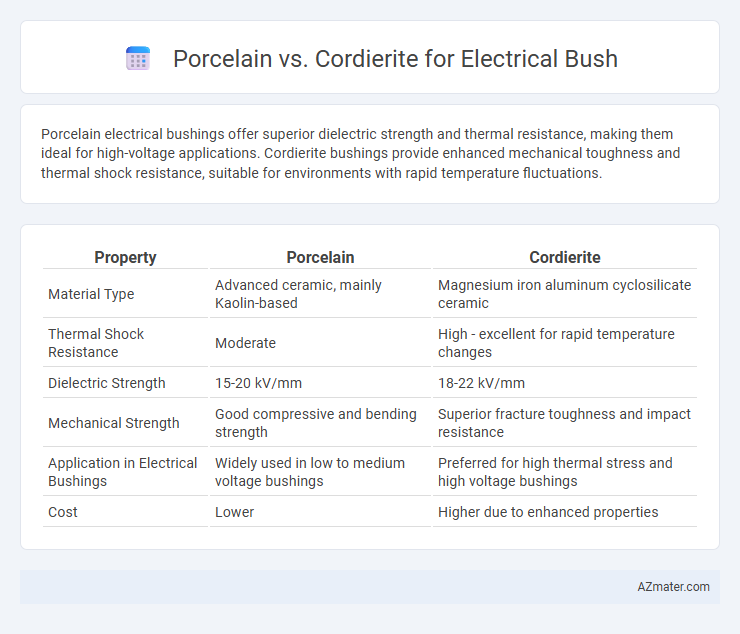Porcelain electrical bushings offer superior dielectric strength and thermal resistance, making them ideal for high-voltage applications. Cordierite bushings provide enhanced mechanical toughness and thermal shock resistance, suitable for environments with rapid temperature fluctuations.
Table of Comparison
| Property | Porcelain | Cordierite |
|---|---|---|
| Material Type | Advanced ceramic, mainly Kaolin-based | Magnesium iron aluminum cyclosilicate ceramic |
| Thermal Shock Resistance | Moderate | High - excellent for rapid temperature changes |
| Dielectric Strength | 15-20 kV/mm | 18-22 kV/mm |
| Mechanical Strength | Good compressive and bending strength | Superior fracture toughness and impact resistance |
| Application in Electrical Bushings | Widely used in low to medium voltage bushings | Preferred for high thermal stress and high voltage bushings |
| Cost | Lower | Higher due to enhanced properties |
Introduction to Electrical Bushings
Electrical bushings serve as critical insulating interfaces in high-voltage equipment, allowing conductors to pass safely through grounded barriers. Porcelain bushings offer excellent mechanical strength and weather resistance, making them suitable for outdoor applications with high electrical stress. Cordierite bushings provide superior thermal shock resistance and dimensional stability, ideal for environments prone to rapid temperature fluctuations in electrical systems.
What is Porcelain?
Porcelain is a durable, non-porous ceramic material composed primarily of kaolin clay, feldspar, and quartz, fired at high temperatures to achieve exceptional electrical insulation properties. It is widely used for electrical bushings due to its high mechanical strength, resistance to thermal shock, and excellent dielectric performance. Porcelain's smooth surface and low moisture absorption help prevent electrical discharges, making it ideal for high-voltage insulator applications.
What is Cordierite?
Cordierite is a magnesium iron aluminum cyclosilicate known for its excellent thermal shock resistance and high dielectric strength, making it ideal for electrical bushing applications. Unlike porcelain, which is primarily composed of kaolin and silica, cordierite offers superior durability under rapid temperature changes and reduces the risk of cracking. Its low thermal expansion coefficient and strong insulating properties enhance the longevity and safety of electrical bushings in high-voltage environments.
Key Properties Comparison: Porcelain vs Cordierite
Porcelain electrical bushings exhibit excellent electrical insulation, high mechanical strength, and superior resistance to weathering and thermal shock, making them ideal for high-voltage applications. Cordierite bushings offer exceptional thermal shock resistance and low dielectric constant, combined with superior mechanical durability and resistance to thermal expansion, which enhances their performance under rapid temperature changes. The choice between porcelain and cordierite depends on specific application requirements such as voltage level, thermal stability, and mechanical stress tolerance.
Thermal Performance in Electrical Applications
Porcelain exhibits high dielectric strength and excellent thermal stability, making it ideal for electrical bushings exposed to fluctuating temperatures. Cordierite offers superior thermal shock resistance and lower thermal expansion, reducing the risk of cracking under rapid temperature changes in electrical applications. Cordierite's enhanced thermal performance extends the lifespan of electrical bushings in environments with frequent thermal cycling compared to traditional porcelain.
Dielectric Strength and Insulation Capabilities
Porcelain offers high dielectric strength typically around 10 to 20 kV/mm, providing excellent insulation capabilities suitable for electrical bushings in high-voltage applications. Cordierite, while also used for electrical insulation, generally exhibits lower dielectric strength, approximately 8 to 12 kV/mm, but benefits from superior thermal shock resistance compared to porcelain. The choice between porcelain and cordierite for electrical bushings depends on balancing dielectric strength requirements with the need for thermal stability and mechanical durability.
Mechanical Strength and Durability
Porcelain electrical bushings exhibit high mechanical strength with excellent resistance to compression and impact, making them suitable for heavy-duty applications. Cordierite offers superior thermal shock resistance and durability under fluctuating temperatures, maintaining structural integrity in harsh environments. Both materials ensure long-lasting performance, but cordierite's enhanced resilience against thermal cycling often results in extended service life for electrical bushings.
Cost-Effectiveness and Availability
Porcelain electrical bushings offer a balance of moderate cost and widespread availability, making them a cost-effective choice for many standard electrical applications. Cordierite bushings, while typically more expensive, provide superior thermal shock resistance and durability, justifying their higher upfront cost in high-stress environments. The broader market availability and lower price point of porcelain components make them ideal for budget-sensitive projects, whereas cordierite is preferred for long-term reliability despite the higher initial investment.
Application Suitability: Industry Preferences
Porcelain electrical bushings excel in high-voltage insulation and moisture resistance, making them preferred in power transmission and utility industries. Cordierite bushings offer superior thermal shock resistance and mechanical strength, favored in heavy industrial applications such as steel manufacturing and high-temperature processing. Industry preferences depend on specific operational conditions, with porcelain dominating in consistent electrical environments and cordierite valued for demanding thermal and mechanical stresses.
Conclusion: Choosing the Right Material for Electrical Bushings
Porcelain offers excellent electrical insulation, high mechanical strength, and resistance to thermal shock, making it ideal for standard electrical bushings in medium to high voltage applications. Cordierite provides superior thermal stability and lower dielectric loss, which benefits high-frequency or rapidly fluctuating electrical environments. Selecting the right material depends on the application's voltage requirements, thermal management needs, and environmental conditions.

Infographic: Porcelain vs Cordierite for Electrical Bush
 azmater.com
azmater.com